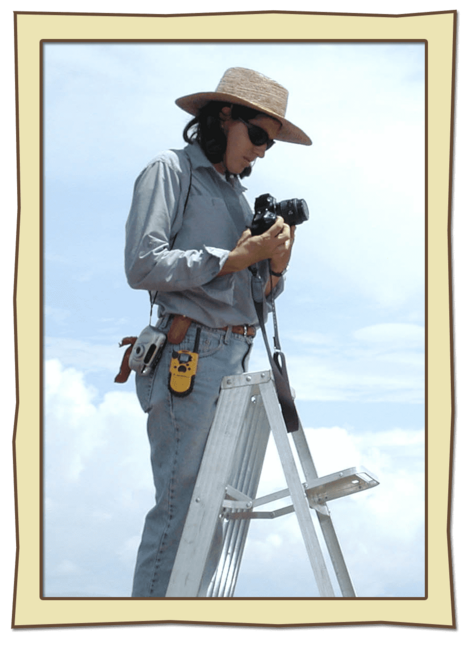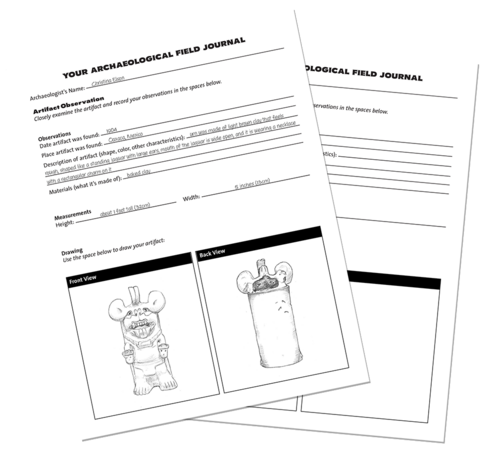

Hi! I'm Christina Elson, an archaeologist at the American Museum of Natural History. I work with the ancient cultures of Mexico. Being an archaeologist is a lot like being a detective: we decipher clues to learn about people of the past and the way they lived. Think of all the things archaeologists have discovered about ancient cultures. For example, today we know a lot about the Aztec religion because archaeologists uncovered their most important temple under modern Mexico City.
But how do archaeologists find out things about people and cultures that disappeared hundreds or even thousands of years ago? We examine the objects they left behind. Every object, or artifact, provides important clues about the people who used it long ago. We closely observe every discovery, record important information, and think about what each artifact tell us about the people who used it.
Now it's your turn to investigate an "artifact" and record your observations in a field journal!
Lost in the Ruins

Many things, such as food and clothing, disappear over time. Fortunately, some things, like pottery, stone, and architecture, can last for centuries. Why do you think some things last and others don't? What is more likely to survive for hundreds of years, a wood tool or a stone tool? Does it matter how something gets buried?
What You'll Need
The Materials


- An object that represents your interests or personality
- Print out of blank field journal
- Print out of Christina's field journal
- Pen or Pencil
What To Do
Start Your Field Journal


Choose an object that represents your interests or personality. For example, you might select a ball, a book, a piece of jewelry, or a school t-shirt.

Have a friend choose an object too.

Switch objects with your friend.

Print out pages for your field journal if you haven't already.

Take a look at Christina's field journal to see how she describes an object from the part of Mexico she studies.

Closely observe your friend's artifact and record your "Artifact Observations" in the field journal.

Next, use your observations to complete the "Artifact Analysis."
Keep Filling Up Your Field Journal

Explore lots of other artifacts and keep adding new pages to your journal. Create a cover for your field journal that reflects the place or themes behind your artifacts. For example, you might draw a map marking the city where your artifacts were found. Be sure to include your name and the date of your discoveries.
Here are some ideas to help fill your journal:
- Find other artifacts that reflect different parts of your life. For example, find an artifact that represents your school, your community, or sports team. Instead of trading with a friend, examine each object yourself.
- What other kinds of artifacts was it used with?
- Look for an object that comes from a different place, such as a souvenir from a trip. (If you don't have the object in front of you, print a picture from a book or Web site to help you describe it.)
- Describe an artifact from another time, such as an old-fashion phone, an arrowhead you found at the park, or a piece of clothing from your parent's childhood.
Take a Closer Look

Chances are, the objects you choose are ones you've seen many times. But take a closer look and you might see new details you've never noticed before. Use a magnifying glass if you have one. Is the object worn in certain places? Does it have any small words or inscriptions? As you describe your object, be very specific and include these little details. Imagine describing the object to someone who doesn't know what it is or can't see it.
Image Credits:
Photos: Christina in the field: courtesy of Christina Elson; What to Do: all photos: courtesy of AMNH




 Biodiversity
Biodiversity
 Brain
Brain
 Genetics
Genetics
 Marine BiOLogy
Marine BiOLogy
 MicrobiOLogy
MicrobiOLogy
 PaleontOLogy
PaleontOLogy
 ZoOLogy
ZoOLogy
 AnthropOLogy
AnthropOLogy
 ArchaeOLogy
ArchaeOLogy
 Astronomy
Astronomy
 Climate Change
Climate Change
 Earth
Earth
 Physics
Physics
 Water
Water
